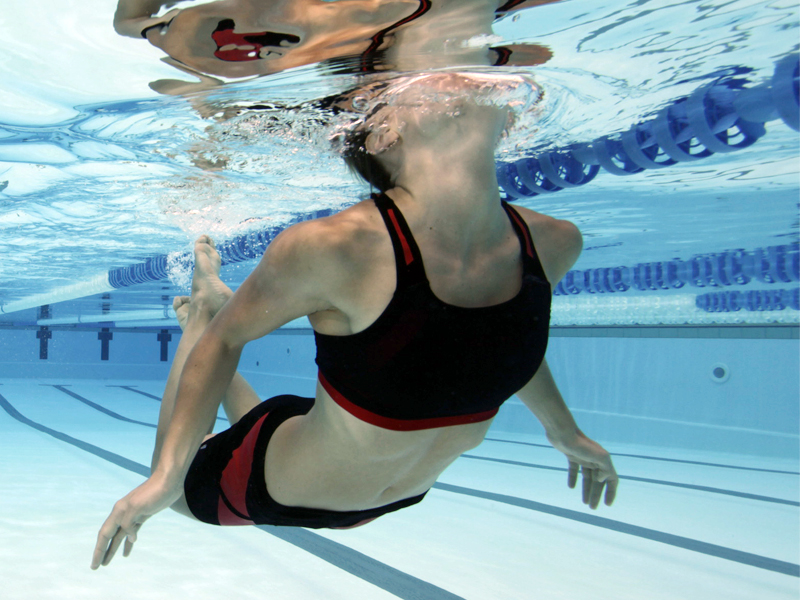Aquagym is undoubtedly the forerunner of all aquafitness courses, the first and still most practiced around the world. This said, since the 1990’s, the list has grown extensively, now including activities such as:
Aqua Building, Aqua Circuit, Aqua Dance, Aqua Gym, Aqua Pilates, Aqua Spinning, Aqua Stretching, Aqua Tonic, Aqua Training, Aqua Zumba, Aquabike, Aquaboxe, Aqua-Chi, AquaDecathlon, AquaDeep, Aquadinamic, Aquaerobic, Aquafitness, Aquaflap, Aquajocks, Aquasenior, Aquasoma, Aquastep, Aquatic Kickboxing, Aquatic Samba, Aquatic soccer, AquaticGym, Aquatic Therapy, GymDiving, Gymswim, GymTantra, Hydroaerobic, Hydro-Step, Latino Water Dance, LatinoSplash, Scubagym, Water Combat, Water Dance, Waterpower, Waterwalking, Watsu, Woga, etc. and this just to mention a few!
Exercises adopted from racing, boxing, aerobics, Pilates, Yoga, or Zumba become more harmonious when performed in the water: the very first requirement for practicing Aquafitness properly, is to find a pool that allows you gain a stable, upright position, with arms out of the water.
Aquafitness is suitable for everyone, but it is especially loved and performed by women, who practice daily, in both summer and winter. As Aquafitness provides training and preparation for other sports, it is practiced more and more by athletes, champions or beginners of any age, for injury prevention or therapy.
Without the need to swim, the workout is tough and the music is loud, like a kind of water-disco! If you have good stability in the water, the execution is easier, more beneficial, and a lot of fun. At the very beginning, Aquafitness could be performed without the use of equipment, however, this has changed and many courses nowadays do ask that it is accompanied by items, such as elastic bands, rings, balls, belts, gloves and water noodles.
It sounds strange, but any kind of Aquafitness course leverages the principle set forth by the law of Archimedes, for which a body immersed in a fluid receives a push from the bottom upwards equal to the weight of the volume of liquid displaced.
Basic tips to helps maximize your Aquafitness workout:
- choose appropriate workout wear, that allows you to move freely
- use aqua sneakers that have arch support and water drainage holes
- bring a bottle of water with you to the pool
- remember to perform a total-body stretch at the end of your session.
The following is just a guide, created to help you decide on the Aquafitness discipline best suited to you:
AQUAGYM or WATERAEROBICS
In Aquagym, the speed of the music determines the effectiveness of the workout. The water offers resistance, buoyancy and a massage effect, which helps tone the muscles and model the body.
By moving and jumping in the water, you create a slight, but constant action which helps facilitate a better functioning of the natural lymphatic drainage: just a few lessons will help the body regain tone and feel lighter. Practice it at the end of the day, to help you to slow down, de-stress and relax.
AQUATRAINING
Aquatraining was originally designed to deliver the motivated athletes with an intense, challenging and effective workout. It is now encouraged to those with a strict desire for muscle tone and development who need to be easy on the joints. Practice early in the morning, so you have energy and strength to face the busy day ahead.
AQUATONIC
Aquatonic is composed of soft and graceful exercises that leverage the effectiveness of the water. It helps loosen the joints, strengthen the muscles, stimulate the blood circulation and release tension in the back. Best practiced in the morning.
AQUA ZUMBA
Aqua Zumba integrates the Zumba philosophy with traditional aqua fitness disciplines. By blending these elements, you create a healthy exercise for the heart, as well as being able to tone up your body, and most importantly, have fun. There’s always time for music and fun. Best practiced in the daytime.
Keep on following us! In the next episode, we will investigate AquaPilates, Woga, and other forms of Aquafitness and related equipment.
